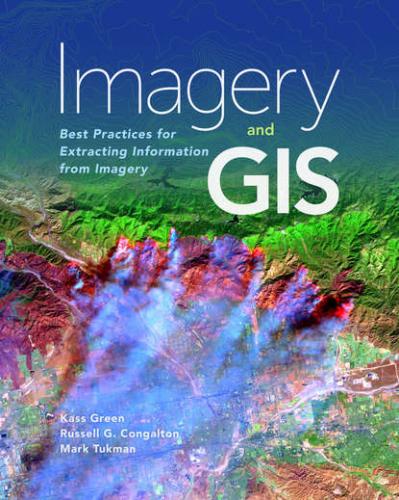The UAS proved to be a cost-effective, safe, efficient, and rapid way of mapping woody debris in the Great Brook. Without UAS technology, it is highly unlikely that the engineering team would have had the information they needed to complete their study. Fundamentally, the data stemming from the UAS was like any other remotely sensed data. The information gleaned from it, through manual interpretation, was done using methods employed by humans for decades. What was unique was the low-cost, flexible, and rapid response that the UAS offered.
Figure 4.A. UAV images and maps of debris along the Great Brook pre- and post-storm. Source: University of Vermont Spatial Analysis Lab
Sources of Passive Panchromatic and Multispectral Imagery
High- and Very-High Spatial Resolution
By far the largest amount of imagery is collected from HVH-spatial-resolution multispectral and panchromatic passive sensors on all platform types including UASs. These sensors provide the imagery that is the source of most maps of streets, buildings, soil types, hydrologic features, airports, crops, forests, wetlands, military facilities, and topography.
All early passive sensors were flown on aircraft (initially balloons) and relied upon panchromatic film imaging surfaces. In the 1930s, Kodak introduced color aerial camera film. Satellite civilian digital satellite scanners were introduced with the launch of Landsat 1 in 1972, and civilian digital airborne systems were introduced in the 1990s. While it is still possible to collect airborne imagery with film cameras, they are in little use. However, much of the long-term archive of remotely sensed imagery exists in film archives, and any change detection for the years before the 1970s will need to rely on scanned images captured from film positives or negatives.
Most HVH-resolution imagery is collected in either panchromatic or blue, green, red, and near-infra wavelengths. Some systems (e.g., WorldView-2 and -3) collect additional bands. Table 4.2 summarizes the current satellite sources of passive HVH-spatial-resolution panchromatic and multispectral imagery. Within five years, the supply of this type of imagery is anticipated to grow exponentially with the continued adoption of UAS use and the launches of several constellations of satellites by private companies, as shown in figure 4.2 and detailed in table 4.3.
Figure 4.2. The growing supply of high- and very-high-resolution satellite imagery. Source: Euroconsult
Sources of HVH-resolution panchromatic and multispectral imagery include the following:
ArcGIS Online, which offers multiple cached high- and very-high-resolution imagery datasets. Its World Imagery comprises imagery at multiple scales and from multiple sources. ArcGIS Online also dynamically serves four-band NAIP imagery over the lower 48 states (at no charge), and four bands of very-high-resolution Hexagon imagery over parts of the United States, Canada, and Western Europe (for a subscription charge).
Private remote sensing and photogrammetry firms. Many remote sensing and photogrammetry firms operate in countries with open airspace. The companies offer new flights to collect imagery for a charge, with the rights of the imagery usually passing to the purchaser. Most remote sensing firms also archive images captured over the life of the firm. Unfortunately, these archives are often dispersed, held by either the company that collected the photos or the organization that funded the collection. Recently the American Society of Photogrammetry and Remote Sensing established the ASPRS Aerial Data Catalog, which is a tool for locating aerial photography throughout the world (http://www.asprs.org/DPAC/index.php/?view=listmanagerfront). The site is fairly new and has records on only a limited number of archives, but several firms have committed to including their information.
UASs. With relatively little investment (compared to buying an airplane), analysts can purchase their own UASs with panchromatic and/or multispectral sensors. However, the capacities of these systems are still limited, making only relatively small collects possible. A good primer on using UASs can be found and accessed at http://drones.newamerica.org/primer/.
NAIP imagery is collected at a 1-meter resolution over the lower 48 states of the United States over three-year cycles by the USDA Farm Services Agency. The program initially relied on true color film sensors when it started in 2003, but transitioned to four-band (R, G, B, and near-infrared [NIR]) digital sensors in 2009. The imagery is available for free download and without license restriction from APFO as compressed .sid (2003–2007) or JPEG 2000 (2008 to the present) files of digital ortho quarter quad mosaics. NAIP imagery can also be downloaded from USGS EROS as JPEG 2000 digital quarter quads (https://lta.cr.usgs.gov/NAIP). Additionally, some states (e.g., California) both serve and provide access for downloading uncompressed NAIP imagery for their state and, as mentioned before, ArcGIS Online serves all four bands of the imagery, providing full access to the raw pixel data. Figure 4.3 shows the current cycle of NAIP imagery by state.
Table 4.2. Comparison of current commercial high- and very-high-spatial-resolution satellites (esriurl.com/IGT42 for current version.)
Table 4.3. Planned near-term launches of high- and very-high-spatial-resolution panchromatic and multispectral imagery (esriurl.com/IGT43 for current version.)
Hexagon. Esri and Leica Geosystems have partnered to serve 15- and 30-cm aerial imagery over much of the United States, Canada, and Europe. In the United States, the Hexagon imagery is a higher-spatial-resolution version of the NAIP imagery, with the same collection interval. Two products are available, the Basemap Service, which is cached true color imagery, and the Multispectral Imagery Service, which provides access to all four bands served across the web for use in ArcGIS software and applications. The imagery is available as a subscription service and is available from the ArcGIS Marketplace, Hexagon Geospatial’s Power Portfolio, and Valtus.
Figure 4.3. Current cycle of NAIP imagery by state (esriurl.com/IG43)
Commercial Satellite Imagery Providers. DigitalGlobe and Airbus are the two largest and longest-established HVH-resolution commercial satellite imagery
